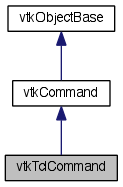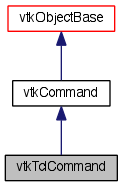#include <vtkTclUtil.h>


Public Member Functions | |
| void | SetStringCommand (const char *arg) |
| void | SetInterp (Tcl_Interp *interp) |
| void | Execute (vtkObject *, unsigned long, void *) |
Static Public Member Functions | |
| static vtkTclCommand * | New () |
Public Attributes | |
| char * | StringCommand |
| Tcl_Interp * | Interp |
Protected Member Functions | |
| vtkTclCommand () | |
| ~vtkTclCommand () | |
Detailed Description
Definition at line 63 of file vtkTclUtil.h.
Constructor & Destructor Documentation
| vtkTclCommand::vtkTclCommand | ( | ) | [protected] |
| vtkTclCommand::~vtkTclCommand | ( | ) | [protected] |
Member Function Documentation
| static vtkTclCommand* vtkTclCommand::New | ( | void | ) | [inline, static] |
Create an object with Debug turned off, modified time initialized to zero, and reference counting on.
Reimplemented from vtkObjectBase.
Definition at line 66 of file vtkTclUtil.h.
| void vtkTclCommand::SetStringCommand | ( | const char * | arg | ) |
| void vtkTclCommand::SetInterp | ( | Tcl_Interp * | interp | ) | [inline] |
Definition at line 69 of file vtkTclUtil.h.
| void vtkTclCommand::Execute | ( | vtkObject * | caller, |
| unsigned | eventId, | ||
| void * | callData | ||
| ) | [virtual] |
All derived classes of vtkCommand must implement this method. This is the method that actually does the work of the callback. The caller argument is the object invoking the event, the eventId parameter is the id of the event, and callData parameter is data that can be passed into the execute method. (Note: vtkObject::InvokeEvent() takes two parameters: the event id (or name) and call data. Typically call data is NULL, but the user can package data and pass it this way. Alternatively, a derived class of vtkCommand can be used to pass data.)
Implements vtkCommand.
Member Data Documentation
Definition at line 73 of file vtkTclUtil.h.
| Tcl_Interp* vtkTclCommand::Interp |
Definition at line 74 of file vtkTclUtil.h.
The documentation for this class was generated from the following file:
- /Users/kitware/Dashboards/MyTests/VTK_BLD_Release_docs/Utilities/Doxygen/dox/Wrapping/Tcl/vtkTclUtil.h
 1.8.0
1.8.0